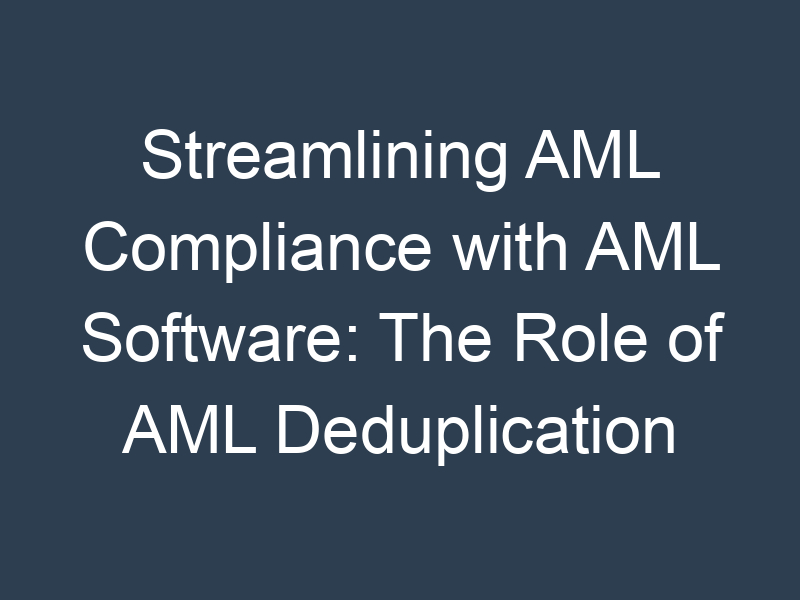Streamlining AML Compliance with AML Software: The Role of AML Deduplication and Data Cleaning
Anti-Money Laundering (AML) compliance is a paramount concern for financial institutions and businesses worldwide. With the ever-evolving landscape of financial crimes, organizations need robust tools and strategies to stay ahead of potential threats. This is where AML software comes into play. In this article, we will explore the significance of AML software, its role in compliance, and the specific contributions of AML Deduplication Software and Data Cleaning Software in enhancing its effectiveness.
Understanding AML Software
AML Software, short for Anti-Money Laundering Software, is a specialized solution designed to help organizations detect and prevent money laundering activities, terrorist financing, and other financial crimes. It utilizes advanced algorithms and data analytics to scrutinize vast amounts of financial data, identify suspicious transactions, and generate alerts for further investigation.
AML Compliance Software
One of the primary functions of AML software is to ensure compliance with AML regulations and guidelines. Financial institutions are mandated to establish robust AML programs to mitigate risks associated with money laundering. AML Compliance Software plays a pivotal role in helping organizations meet these regulatory requirements.
Key features of AML Compliance Software include:
a. Customer Due Diligence (CDD): AML Compliance Software allows organizations to perform thorough background checks on customers and assess their risk levels. This aids in identifying high-risk customers and applying enhanced due diligence measures when necessary.
b. Transaction Monitoring: The software continuously monitors transactions for unusual patterns or red flags. It can detect anomalies such as large cash transactions, frequent international transfers, or suspicious account activity.
c. Watchlist Screening: AML Compliance Software checks customer information against various watchlists, including government-sanctioned lists and internal databases, to identify individuals or entities linked to terrorism or criminal activities.
AML Deduplication Software
AML Deduplication Software is a specialized component of AML software that addresses a common challenge in compliance: duplicate records. Duplicate records can lead to inaccurate risk assessments and missed opportunities to detect suspicious activities.
Key benefits of AML Deduplication Software include:
a. Enhanced Accuracy: By identifying and merging duplicate records, AML Deduplication Software ensures that customer information is accurate and up-to-date, reducing false positives and enhancing the overall effectiveness of AML programs.
b. Efficiency: Manual deduplication processes can be time-consuming and error-prone. AML Deduplication Software automates this task, saving time and reducing the risk of human error.
c. Unified Customer View: By consolidating duplicate records, organizations gain a single, comprehensive view of each customer, allowing for better risk assessment and compliance decision-making.
Data Cleaning Software
Data quality is essential for the effectiveness of AML software. Poor-quality data can result in false positives, missed alerts, and compliance failures. Data Cleaning Software plays a vital role in ensuring that the data used by AML systems is accurate, complete, and consistent.
Key functions of Data Cleaning Software in the context of AML include:
a. Data Validation: Data Cleaning Software validates customer information by checking it against predefined rules and formats. It ensures that names, addresses, and other critical data elements are correctly formatted and adhere to regulatory standards.
b. Data Enrichment: In addition to validation, Data Cleaning Software can enrich customer data by appending additional information, such as demographic data or geolocation data. This enriched data can enhance risk assessment and investigation capabilities.
c. Data Standardization: AML systems often deal with data from multiple sources, which may use different formats and standards. Data Cleaning Software standardizes data to ensure consistency, making it easier for AML algorithms to analyze information accurately.
Conclusion
In the ever-evolving landscape of financial crimes, AML compliance remains a top priority for organizations. AML Software plays a critical role in helping businesses and financial institutions detect and prevent money laundering activities and other illicit financial transactions. Moreover, the integration of AML Deduplication Software and Data Cleaning Software into AML programs enhances their accuracy, efficiency, and effectiveness.
As regulatory scrutiny continues to increase, organizations must invest in robust AML solutions to safeguard their operations and maintain the trust of their customers and stakeholders. By leveraging AML Software alongside AML Deduplication and Data Cleaning solutions, businesses can achieve a higher level of compliance while minimizing the risks associated with financial crimes.







